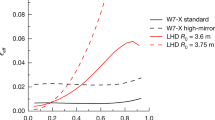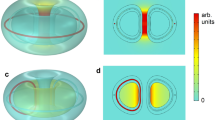Abstract
The two leading concepts for confining high-temperature fusion plasmas are the tokamak and the stellarator. Tokamaks are rotationally symmetric and use a large plasma current to achieve confinement, whereas stellarators are non-axisymmetric and employ three-dimensionally shaped magnetic field coils to twist the field and confine the plasma. As a result, the magnetic field of a stellarator needs to be carefully designed to minimize the collisional transport arising from poorly confined particle orbits, which would otherwise cause excessive power losses at high plasma temperatures. In addition, this type of transport leads to the appearance of a net toroidal plasma current, the so-called bootstrap current. Here, we analyse results from the first experimental campaign of the Wendelstein 7-X stellarator, showing that its magnetic-field design allows good control of bootstrap currents and collisional transport. The energy confinement time is among the best ever achieved in stellarators, both in absolute figures (τE > 100 ms) and relative to the stellarator confinement scaling. The bootstrap current responds as predicted to changes in the magnetic mirror ratio. These initial experiments confirm several theoretically predicted properties of Wendelstein 7-X plasmas, and already indicate consistency with optimization measures.
This is a preview of subscription content, access via your institution
Access options
Access Nature and 54 other Nature Portfolio journals
Get Nature+, our best-value online-access subscription
$29.99 / 30 days
cancel any time
Subscribe to this journal
Receive 12 print issues and online access
$209.00 per year
only $17.42 per issue
Buy this article
- Purchase on Springer Link
- Instant access to full article PDF
Prices may be subject to local taxes which are calculated during checkout






Similar content being viewed by others
Change history
11 September 2018
In the version of this Article originally published, and in the associated Publisher Correction, the members of the W7-X Team were not included. All versions of the Article, and the Publisher Correction, have now been amended to include these team members.
03 July 2018
In the version of this Article originally published, A. Mollén’s affiliation was incorrectly denoted as number 10; it should have been 1. Throughout the Article, some technical problems in typesetting meant that the tilde symbol above b and one instance of a superscript 2 were too high to be visible; see the correction notice for details. Finally, the citation to ref. 35 on page one of the Supplementary Information was incorrect; it should have been to ref. 36. These issues have now been corrected.
References
Spitzer, L. The stellarator concept. Phys. Fluids 1, 253–264 (1958).
Helander, P. et al. Stellarator and tokamak plasmas: a comparison. Plasma Phys. Contr. Fusion 54, 124009 (2012).
Galeev, A. A., Sagdeev, R. Z., Furth, H. P. & Rosenbluth, M. N. Plasma diffusion in a toroidal stellarator. Phys. Rev. Lett. 22, 511–514 (1969).
Beidler, C. D. & Hitchon, W. N. G. Ripple transport in helical-axis advanced stellarators: a comparison with classical stellarators/torsatrons. Plasma Phys. Contr. Fusion 36, 317–353 (1995).
Yokoyama, M. et al. Core electron-root confinement (CERC) in helical plasmas. Nucl. Fusion 47, 1213–1219 (2007).
Galeev, A. A. & Sagdeev, R. Z. in Reviews of Plasma Physics Vol. 7 (ed. Leontovich, M. A.) 257–343 (Consultants Bureau, New York, NY, 1979)
Palumbo, D. Some considerations on closed configurations of magnetohydrostatic equilibrium. Nuovo Cim. B X53, 507–511 (1968).
Nührenberg, J. Development of quasi-isodynamic stellarators. Plasma Phys. Contr. Fusion 52, 124003 (2010).
Nührenberg, J. & Zille, R. Stable stellarators with medium β and aspect ratio. Phys. Lett. A 114, 129–132 (1986).
Galeev, A. A. Diffusion-electrical phenomena in a plasma confined in a tokamak machine. Sov. Phys. JETP 32, 752–757 (1971).
Bickerton, R. J., Connor, J. W. & Taylor, J. B. Diffusion driven plasma currents and bootstrap tokamak. Nature 229, 110–112 (1971).
Zarnstorff, M. C. et al. Bootstrap current in TFTR. Phys. Rev. Lett. 60, 1306–1309 (1988).
Murakami, M. et al. Bootstrap-current experiments in a toroidal plasma-confinement device. Phys. Rev. Lett. 66, 707–710 (1991).
Helander, P. & Nührenberg, J. Bootstrap current and neoclassical transport in quasi-isodynamic stellarators. Plasma Phys. Contr. Fusion 51, 055004 (2009).
Landreman, M. & Catto, P. J. Omnigenity as generalized quasisymmetry. Phys. Plasmas 19, 056103 (2012).
Hirsch, M. et al. Major results from the stellarator Wendelstein 7-AS. Plasma Phys. Contr. 50, 053001 (2008).
Sunn Pedersen, T. et al. Confirmation of the topology of the Wendelstein 7-X magnetic field to better than 1:100,000. Nat. Commun. 7, 13493 (2016).
Bozhenkov, S. A. et al. Effect of error field correction coils on W7-X limiter loads. Nucl. Fusion 57, 126030 (2017).
Sunn Pedersen, T. et al. Plans for the first plasma operation of Wendelstein 7-X. Nucl. Fusion 55, 126001 (2015).
Klinger, T. et al. Performance and properties of the first plasmas of Wendelstein 7-X. Plasma Phys. Contr. Fusion 59, 014018 (2017).
Wolf, R. C. et al. Major results from the first plasma campaign of the Wendelstein 7-X stellarator. Nucl. Fusion 57, 102020 (2017).
Sunn Pedersen, T. et al. Key results from the first plasma operation phase and outlook for future performance in Wendelstein 7-X. Phys. Plasmas 24, 055503 (2017).
Wolf, R. C. et al. Wendelstein 7-X program—Demonstration of a stellarator option for fusion energy. IEEE Trans. Act. Plasma Sci. 44, 1466–1471 (2016).
Wurden, G. A. et al. Limiter observations during W7-X first plasmas. Nucl. Fusion 57, 056036 (2017).
Yamada, H. et al. Characterization of energy confinement in net-current free plasmas using the extended International Stellarator Database. Nucl. Fusion 45, 1684–1693 (2005).
Stroth, U. et al. Energy confinement scaling from the International Stellarator Database. Nucl. Fusion 36, 1063–1077 (1996).
Dinklage, A. et al. Physics model assessment of the energy confinement time scaling in stellarators. Nucl. Fusion 47, 1265–1273 (2007).
Hirsch, M. et al. Confinement in Wendelstein 7-X limiter plasmas. Nucl. Fusion 57, 086010 (2017).
Doyle, E. J. et al. Chapter 2: Plasma confinement and transport. Nucl. Fusion 47, S18–S127 (2007).
Turkin, Yu. et al. Neoclassical transport simulations for stellarators. Phys. Plasmas 18, 022505 (2011).
Turkin, Yu, Maaßberg, H., Beidler, C. D., Geiger, J. & Marushchenko, N. Current control by ECCD for W7-X. Fusion Sci. Technol. 50, 387–394 (2006).
Bosch, H.-S. et al. Final integration, commissioning and start of the Wendelstein 7-X stellarator operation. Nucl. Fusion 57, 116015 (2017).
Marsen, S. et al. First results from protective ECRH diagnostics for Wendelstein 7-X. Nucl. Fusion 57, 086014 (2017).
Moseev, D. et al. Inference of the microwave absorption coefficient from stray radiation measurements in Wendelstein 7-X. Nucl. Fusion 57, 036013 (2017).
Wauters, T. et al. Wall conditioning by ECRH discharges and He-GDC in the limiter phase of Wendelstein 7-X. Nucl. Fusion 58, 066013 (2018).
Beidler, C. D. et al. Benchmarking of the mono-energetic transport coefficients—results from the International Collaboration on Neoclassical Transport in Stellarators (ICNTS). Nucl. Fusion 51, 076001 (2011).
Beidler, C. et al. Physics and engineering design for Wendelstein VII-X. Fusion Technol. 17, 148–168 (1990).
Hirshman, S. P., van Rij, W. I. & Merkel, P. Three-dimensional free boundary calculations using a spectral Green's function method. Comp. Phys. Comm. 43, 143–155 (1986).
Bozhenkov, S. A. et al. Service oriented architecture for scientific analysis at W7-X. An example of a field line tracer. Fusion Eng. Des. 88, 2997–3006 (2013).
Hirshman, S. P., Shaing, K. C., van Rij, W. I. & Crume, E. C. Jr. Plasma transport coefficients for nonsymmetric toroidal confinement systems. Phys. Fluids 29, 2951–2959 (1986).
van Rij, W. I. & Hirshman, S. P. Variational bounds for transport coefficients in three‐dimensional toroidal plasmas. Phys. Fluids B 1, 563–569 (1989).
Landreman, M., Smith, H. M., Mollén, A. & Helander, P. Comparison of particle trajectories and collision operators for collisional transport in nonaxisymmetric plasmas. Phys. Plasmas 21, 042503–042503 (2014).
Marushchenko, N., Turkin, Yu & Maaßberg, H. Ray-tracing code TRAVIS for ECR heating, EC current drive and ECE diagnostic. Comp. Phys. Comm. 185, 165–176 (2014).
Feng, Y., Sardei, F., Kisslinger, J., Grigull, P., Mc Cormick, K. & Reiter, D. 3D edge modeling and island divertor physics. Contrib. Plasma Phys. 44, 57–69 (2004).
Effenberg, F. et al. Numerical investigation of plasma edge transport and limiter heat fluxes in Wendelstein 7-X startup plasmas with EMC3-EIRENE. Nucl. Fusion 57, 036021 (2017).
Krychowiak, M. et al. Overview of diagnostic performance and results for the first operation phase in Wendelstein 7-X. Rev. Sci. Instrum. 87, 11D304 (2016).
Endler, M. et al. Engineering design for the magnetic diagnostics of Wendelstein 7-X. Fusion Eng. Des. 100, 468–494 (2015).
Pablant, N. A. et al. Core radial electric field and transport in Wendelstein 7-X plasmas. Phys. Plasmas 25, 022508 (2018).
Krämer-Flecken, A. et al. Investigation of turbulence rotation in limiter plasmas at W7-X with a new installed poloidal correlation reflectometry. Nucl. Fusion 57, 066023 (2017).
Romé, M., Erckmann, V., Gasparino, U. & Karulin, N. Electron cyclotron resonance heating and current drive in the W7-X stellarator. Plasma Phys. Contr. Fusion 40, 511–530 (1998).
Acknowledgements
This work has been carried out within the framework of the EUROfusion Consortium and has received funding from the Euratom research and training programme 2014–2018 under grant agreement 633053. The views and opinions expressed herein do not necessarily reflect those of the European Commission. This work is partially supported by the US Department of Energy under a project agreement with the Max Planck Institute for Plasma Physics.
Author information
Authors and Affiliations
Consortia
Contributions
A.D., C.D.B., P.H., T.S.P., R.C.W. and T.K. wrote the paper. A.D., T.S.P., S.B., F.E. and J.G. prepared the configuration changes and the discharge program. A.D., H.M., Y.T., T.A., A.A., C.D.B., F.E., Y.F., J.G., A.M., N.M., H.M.S. and O.S. did modelling and data validation. K.R., B.B., B.B., A.C., G.F., M.H., U.H., M.J., J.K., G.K., A.K.F., M.K., A.L., H.L., U.N., H.N., E.P., N.P., L.R., T.S., T.S., G.W., T.W., G.W. and D.Z. did measurements and data analysis.
Corresponding author
Ethics declarations
Competing interests
The authors declare no competing interests.
Additional information
Publisher’s note: Springer Nature remains neutral with regard to jurisdictional claims in published maps and institutional affiliations.
Supplementary information
Rights and permissions
About this article
Cite this article
Dinklage, A., Beidler, C.D., Helander, P. et al. Magnetic configuration effects on the Wendelstein 7-X stellarator. Nature Phys 14, 855–860 (2018). https://doi.org/10.1038/s41567-018-0141-9
Received:
Accepted:
Published:
Issue Date:
DOI: https://doi.org/10.1038/s41567-018-0141-9
This article is cited by
-
Observation of a reduced-turbulence regime with boron powder injection in a stellarator
Nature Physics (2022)
-
Demonstration of reduced neoclassical energy transport in Wendelstein 7-X
Nature (2021)
-
Enhanced control
Nature Physics (2018)
-
A hot debut
Nature Physics (2018)



